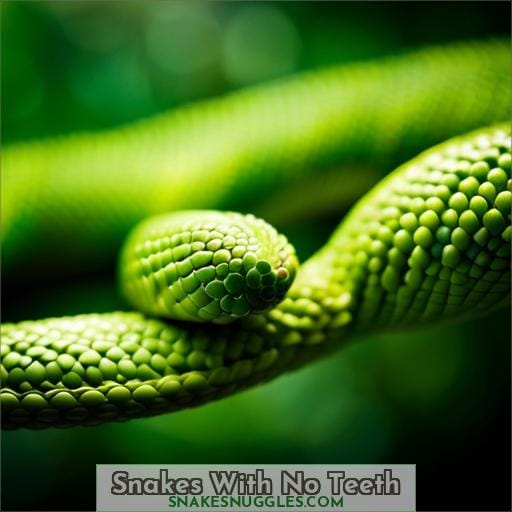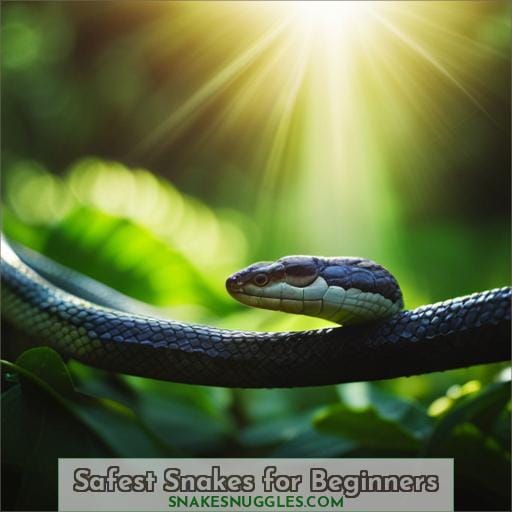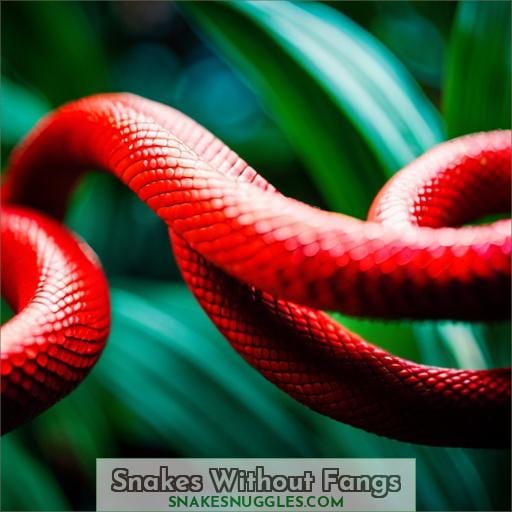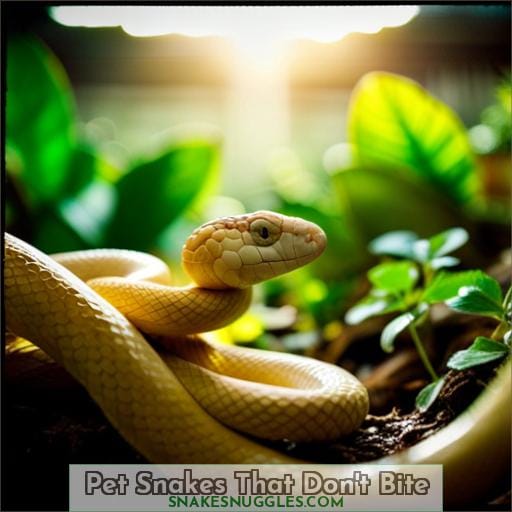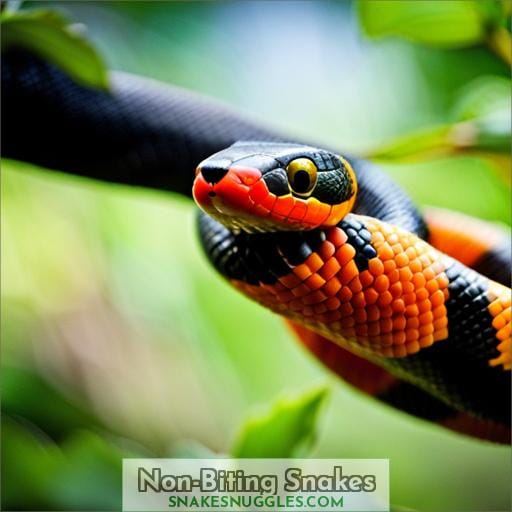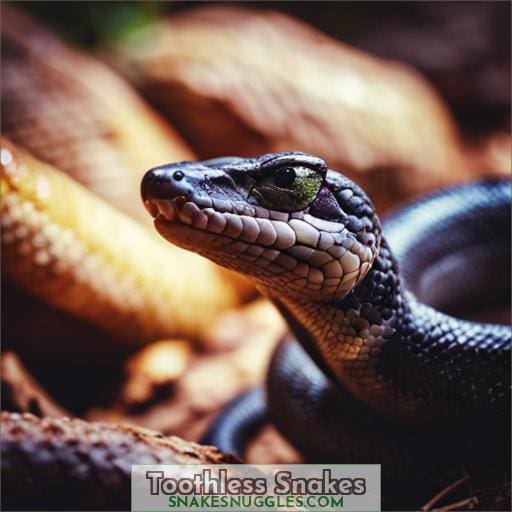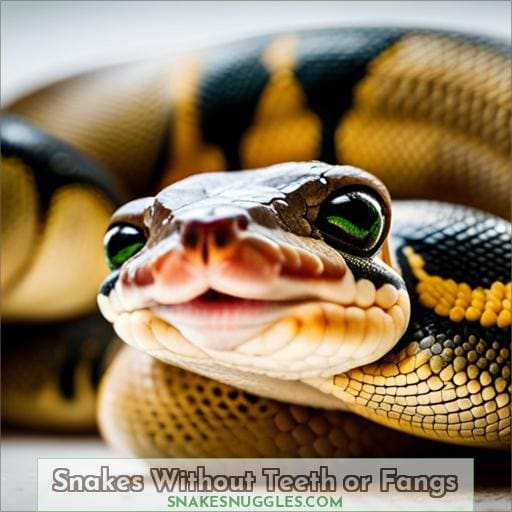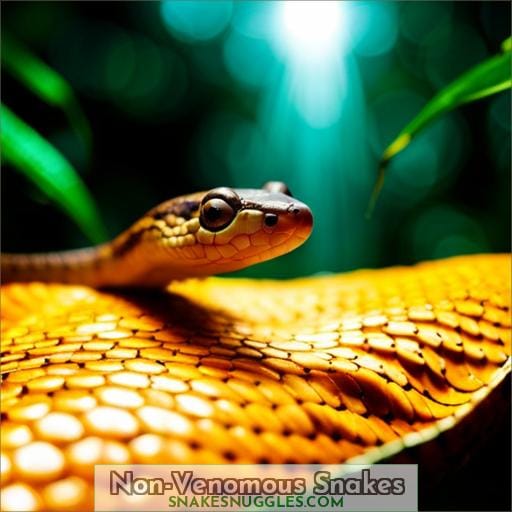This site is supported by our readers. We may earn a commission, at no cost to you, if you purchase through links.
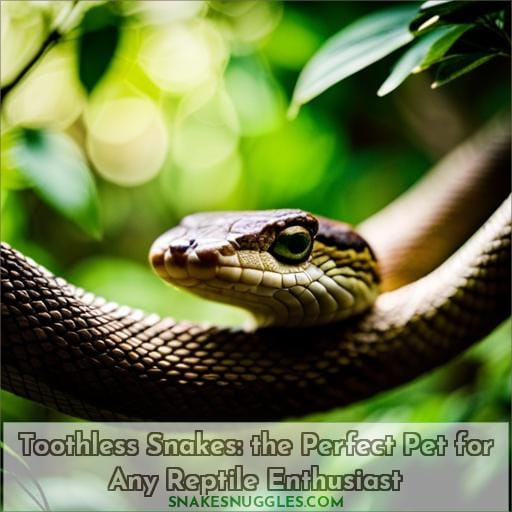 You’ll be shocked by the truth about toothless snakes.
You’ll be shocked by the truth about toothless snakes.
They’re the ideal pet for the reptile enthusiast!
Discover a world of non-biting, non-venomous serpents that bring a unique charm to your home.
Learn about their docile temperaments, fascinating behaviors, and captivating appearances.
Dive into the realm of these toothless wonders and uncover the secrets of their captivating presence.
Table Of Contents
- Key Takeaways
- Snakes With No Teeth
- Safest Snakes for Beginners
- Snakes Without Fangs
- Pet Snakes That Don’t Bite
- Non-Biting Snakes
- Toothless Snakes
- Snakes Without Teeth or Fangs
- Non-Venomous Snakes
- Best Pet Snakes With No Teeth
- Frequently Asked Questions (FAQs)
- What is the average lifespan of a toothless pet snake?
- Are there any specific health concerns associated with toothless snakes that potential owners should be aware of?
- How can I tell if a toothless snake is feeling stressed or uncomfortable in its environment?
- What are some common mistakes that new owners of toothless snakes make that I should avoid?
- Where can I find reputable breeders or rescue organizations that specialize in toothless snakes?
- Conclusion
Key Takeaways
- Toothless snakes make ideal pets for beginners due to their lack of teeth.
- Snakes without fangs offer a rewarding experience with unique behavioral adaptations.
- Several snake species are known for their gentle temperament and lack of biting behavior.
- Non-biting snakes exhibit calm temperaments, diverse appearances, and fascinating behavioral traits.
Snakes With No Teeth
In the world of snakes, you’ll find species with no teeth at all.
These toothless snakes employ unique adaptations to survive and thrive in their environments.
For instance, the Dasypeltis, an egg-eating snake, lacks teeth entirely.
It relies on protrusions inside its mouth to crack eggs and its unhinging jaw to swallow them whole.
Additionally, its excellent climbing capabilities allow it to access bird nests, its primary food source.
Toothless snakes exhibit a diverse range of behaviors and personalities.
Some, like the Indian Egg-Eating Snake, are known for their glossy brown or black scales adorned with blue-white dots and a cream stripe.
Others, such as the Milk Snake, captivate with their vibrant colors and pleasant demeanor, making them popular pets.
The Green Snake, found in the Appalachian region, is renowned for its quiet and docile nature.
Despite their lack of teeth, toothless snakes possess fascinating hissing habits.
By rubbing their scales together, they produce a distinct hissing sound, a defensive mechanism to deter potential predators.
Their climbing capabilities also vary, with some species, like the Dasypeltis, being adept climbers, while others prefer terrestrial habitats.
These toothless wonders offer a unique and rewarding experience for reptile enthusiasts.
Their diverse adaptations, colorful personalities, and non-threatening nature make them ideal pets for those seeking a low-maintenance and captivating companion.
Safest Snakes for Beginners
Now that you’re aware of snakes that lack teeth, let’s delve into the realm of the safest snakes for beginners. These toothless serpents make ideal companions for those seeking a low-maintenance and gentle reptile pet.
Handling Techniques:
Their lack of teeth eliminates the fear of painful bites, making them perfect for handling. However, always handle them with care and respect, avoiding sudden movements that may startle them.
Habitat Design:
Create a comfortable and secure habitat that caters to their specific needs. Provide hiding spots, proper lighting, and appropriate substrate to mimic their natural environment.
Most toothless snakes are carnivorous, with a diet consisting of insects, worms, and small rodents. Research the specific dietary requirements of your chosen species to ensure a healthy and balanced diet.
Health Care:
Regular checkups with an experienced veterinarian are crucial for monitoring their overall health. Pay attention to their behavior, appetite, and any unusual signs to catch potential health issues early on.
With proper care and attention, toothless snakes can thrive as beloved pets, offering a unique and rewarding experience for reptile enthusiasts of all levels.
Snakes Without Fangs
Venturing into snakes without fangs is an equally rewarding experience, offering a variety of docile species to choose from.
These snakes have evolved unique behavioral adaptations to compensate for their lack of fangs, showcasing the incredible diversity of the reptilian world.
Toothless snakes employ various feeding strategies to capture and consume prey.
Some species, like the egg-eating snake, have developed specialized mouth structures that allow them to swallow eggs whole.
Others, such as the slug-eating snake, have evolved unique teeth that help them grip and crush their slimy prey.
Environmental enrichment is crucial for the well-being of snakes without fangs.
Providing them with a habitat that mimics their natural environment, including hiding spots, climbing structures, and a suitable substrate, helps promote their physical and mental health.
Breeding habits vary among toothless snake species.
Some, like the rosy boa, are viviparous, giving birth to live young.
Others, like the corn snake, are oviparous, laying eggs that hatch after a period of incubation.
Understanding their reproductive cycles is essential for successful captive breeding and conservation efforts.
Conservation efforts play a vital role in protecting toothless snakes and their habitats.
Many species face threats such as habitat loss, climate change, and illegal wildlife trade.
By supporting conservation organizations and promoting sustainable practices, you can contribute to the preservation of these fascinating creatures.
Pet Snakes That Don’t Bite
You’ll find several snake species known for their gentle temperament and lack of biting behavior, making them suitable pets for reptile enthusiasts.
These toothless snakes offer a safe and rewarding experience for those who are looking to handle these fascinating creatures without the worry of being bitten.
When it comes to handling techniques, it’s important to approach your pet snake calmly and confidently, avoiding sudden movements that may startle them.
Providing habitat enrichment is crucial in ensuring their well-being, as they thrive in environments that mimic their natural habitats.
Feeding preferences vary among different snake species but generally consist of rodents or other small prey items.
Behavioral observations can help you understand your pet’s needs and preferences better, allowing you to provide appropriate care tailored specifically to them.
Some popular morphs include:
- The Corn Snake with its vibrant colors and ease of handling.
- The Hognose Snake known for its unique upturned snout.
- The Rosy Boa characterized by its docile nature.
- Rubber Boas which make great companions due to their curiosity.
- Garter Snakes commonly found across North America with a tame demeanor.
By choosing one of these toothless snakes as a pet, you can enjoy observing their captivating behaviors while feeling assured knowing that they pose no threat through biting or venomous attacks.
Non-Biting Snakes
In addition to their lack of teeth, non-biting snakes are also known for their calm temperaments and ease of handling, making them ideal pets for both experienced and novice snake owners.
These snakes exhibit a remarkable diversity in terms of habitat preferences, ranging from tropical rainforests to arid deserts, and can be found in various parts of the world.
Their captivating appearance, often adorned with vibrant colors and intricate patterns, further enhances their appeal as pets. Many species exhibit fascinating behavioral traits, such as burrowing, climbing, or swimming, adding an element of intrigue to their care.
When it comes to feeding, non-biting snakes typically have specialized diets that cater to their unique physiological needs. Some species primarily consume eggs, while others feed on rodents, insects, or even fish.
Understanding their specific dietary requirements is crucial for ensuring their optimal health and well-being.
Handling non-biting snakes requires a combination of respect and gentle techniques. Always approach them with caution and avoid making sudden movements that may startle them. Support their body fully when picking them up, and handle them in a calm and confident manner.
By providing a suitable habitat, appropriate diet, and responsible handling, you can create a thriving environment for your non-biting snake, allowing it to flourish and become a cherished companion for years to come.
Toothless Snakes
Your toothless snake’s mouth lacks teeth, making it unable to bite or harm you. Instead of teeth, it possesses specialized mouth structures that aid in capturing and consuming prey. Its feeding behaviors have adapted to its unique toothless anatomy, allowing it to thrive in its natural habitats.
Feeding Behaviors:
Toothless snakes exhibit diverse feeding strategies. Some species, like the egg-eating snake, have evolved to consume eggs exclusively. They possess protrusions in their mouths that help crack eggshells, enabling them to swallow eggs whole. Others, such as the milk snake, primarily feed on small rodents and insects. Their lack of teeth doesn’t hinder their ability to capture and swallow prey, demonstrating their adaptability and resilience.
Natural Habitats:
Toothless snakes inhabit a wide range of habitats, including forests, grasslands, and rocky terrains. They can be found in various parts of the world, from tropical rainforests to temperate regions. Their adaptability allows them to thrive in diverse environments, showcasing their resilience and ability to survive in different conditions.
Reproductive Cycles:
Toothless snakes exhibit unique reproductive cycles. Some species lay eggs, while others give birth to live young. Their reproductive behaviors vary depending on the species and environmental factors. Understanding these cycles is crucial for successful captive breeding and conservation efforts, ensuring the survival of these fascinating creatures.
Snakes Without Teeth or Fangs
Starting with the egg-eating snake, let’s explore reptiles that have no teeth or fangs.
These toothless wonders have evolved unique adaptations to survive and thrive in their environments.
Egg-Eating Snake:
- Specialized mouth protrusions for cracking eggs
- Found in Africa and Asia
- Swallow eggs whole
- Lay eggs
- Require nesting sites and climbing opportunities
Rubber Boa:
- Non-venomous, rarely uses fangs
- Native to North America
- Ambush predator, constricts prey
- Gives birth to live young
- Thrive with hiding spots, burrows, and a varied diet
Ball Python:
- Non-venomous, constrictor
- Originates from Africa
- Ambush predator, constricts prey
- Lay eggs
- Require hiding spots, climbing structures, and a humid environment
Understanding their natural habitats and feeding habits is crucial for providing proper care.
Creating a stimulating environment is essential for their well-being.
Non-Venomous Snakes
Non-venomous snakes lack fangs and toxins, making them a safer choice for those concerned about bites or venom.
However, this doesn’t mean they’re devoid of fascinating characteristics and behaviors.
Delve into the world of non-venomous snakes and discover their intriguing behavioral patterns, habitat preferences, reproductive cycles, dietary requirements, and environmental enrichment needs.
Garter snakes, with their vibrant colors and curious nature, are common inhabitants of North America.
They thrive in diverse habitats, from marshes to meadows, and exhibit unique hunting behaviors, often ambushing their prey with lightning speed.
Hognose snakes, known for their distinctive upturned snout, are fascinating creatures that play dead when threatened, making them appear vulnerable and harmless.
Rat snakes, renowned for their climbing abilities, are arboreal residents that inhabit forests and woodlands.
They’re active hunters, pursuing rodents and birds with agility and precision.
Corn snakes, popular pets due to their docile nature and striking patterns, are found in various habitats, including fields, forests, and barns.
Their adaptability and hardiness make them excellent choices for novice snake enthusiasts.
Understanding these non-venomous snakes‘ behavioral patterns, habitat preferences, reproductive cycles, dietary requirements, and environmental enrichment needs is crucial for providing them with optimal care and ensuring their well-being.
Whether you’re an experienced herpetologist or a curious beginner, exploring the world of non-venomous snakes offers endless opportunities for learning, appreciation, and fascination.
Best Pet Snakes With No Teeth

If you’re seeking the safest and most beginner-friendly snake, look no further than toothless snakes, renowned for their gentle nature and inability to inflict harm. Their lack of teeth eliminates the risk of painful bites, making them ideal companions for reptile enthusiasts of all experience levels.
Behavioral Traits:
Toothless snakes exhibit docile and calm temperaments, rarely displaying aggression. They’re generally curious and inquisitive, making them engaging pets to observe and interact with.
Enclosure Requirements:
These snakes thrive in enclosures that mimic their natural habitats, with ample space for movement, hiding spots, and a substrate suitable for burrowing. Maintaining proper temperature and humidity levels is crucial for their well-being.
Handling Techniques:
Gentle handling is essential to ensure the snake’s comfort and safety. Avoid sudden movements and support their body fully when picking them up. Regular handling helps build trust and acclimates them to human interaction.
Toothless snakes have specialized diets, often consisting of eggs, insects, or small rodents. It’s crucial to research their specific dietary needs and provide them with a balanced and nutritious diet.
Lifespan Expectations:
With proper care, toothless snakes can live for several years, providing years of companionship and enjoyment. Their longevity makes them a long-term commitment, so be prepared to provide them with a loving and nurturing home for their entire lifespan.
Frequently Asked Questions (FAQs)
What is the average lifespan of a toothless pet snake?
With proper care, toothless pet snakes can live over a decade.
Their extended lifespan allows you to cultivate a strong bond and enjoy their companionship for many years.
Are there any specific health concerns associated with toothless snakes that potential owners should be aware of?
Toothless snakes, like the charming Milk Snake, lack fangs and visible teeth, rendering their bites harmless.
However, their delicate mouths require specialized care to prevent infection and maintain proper oral hygiene.
How can I tell if a toothless snake is feeling stressed or uncomfortable in its environment?
To gauge a toothless snake’s stress levels, closely monitor its behavior and environment.
Signs of discomfort include:
- Hiding excessively
- Refusing food
- Changes in defecation or urination patterns
- Erratic movements
What are some common mistakes that new owners of toothless snakes make that I should avoid?
Avoid the common misstep of assuming toothless snakes are harmless.
While they lack fangs, their sharp teeth can still inflict pain.
Handle with care, respect their boundaries, and seek guidance from experienced keepers.
This will ensure a harmonious coexistence.
Where can I find reputable breeders or rescue organizations that specialize in toothless snakes?
Explore reputable breeders and rescue organizations specializing in toothless snakes.
Their expertise ensures healthy, well-bred companions, minimizing risks associated with inexperienced breeders.
Conclusion
Aren’t you curious about the wonders of a toothless snake’s world?
These remarkable creatures, stripped of fangs and biting capabilities, offer a fascinating and gentle experience for reptile enthusiasts.
Their docile temperaments and captivating appearances make them ideal pets, inviting you to witness their unique behaviors and unravel the secrets of their captivating presence.
Embark on this journey into the realm of toothless serpents, and discover the best pet snake with no teeth that will bring joy and intrigue to your life.

